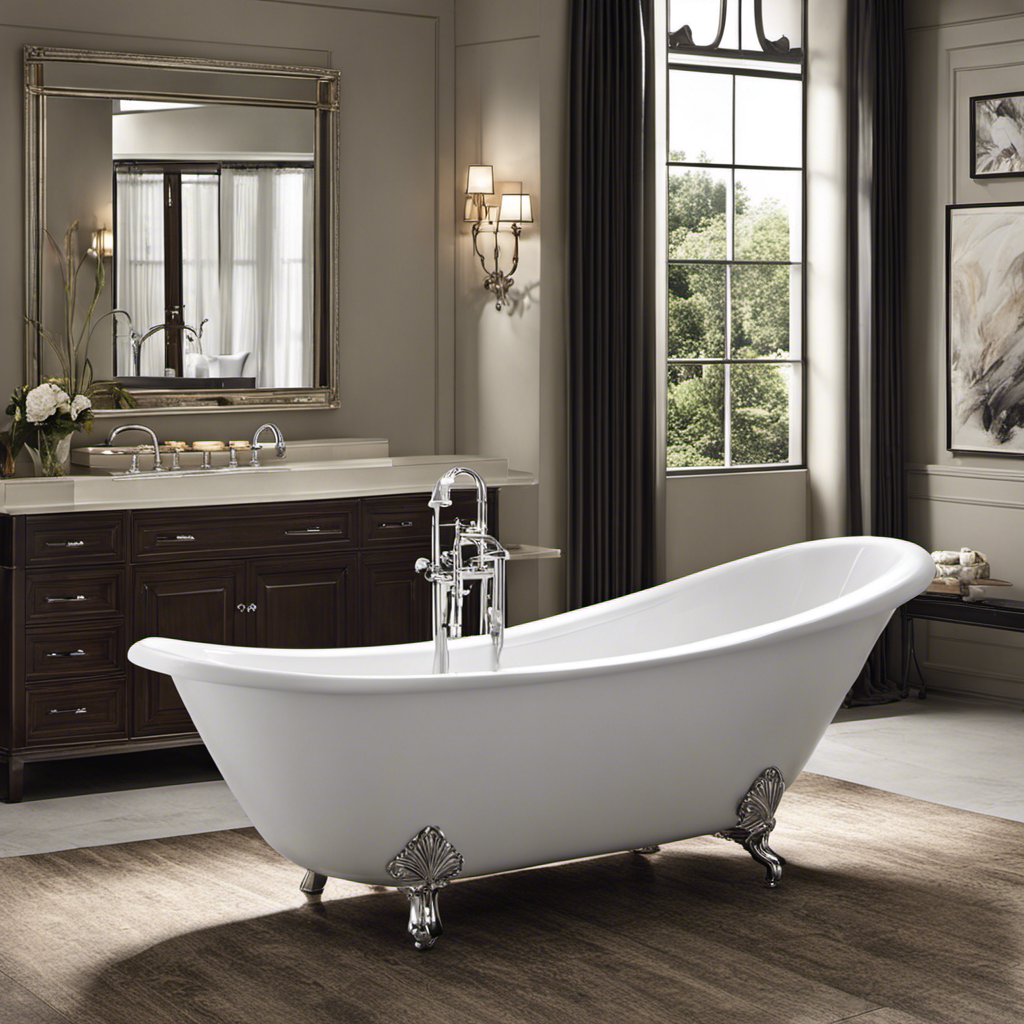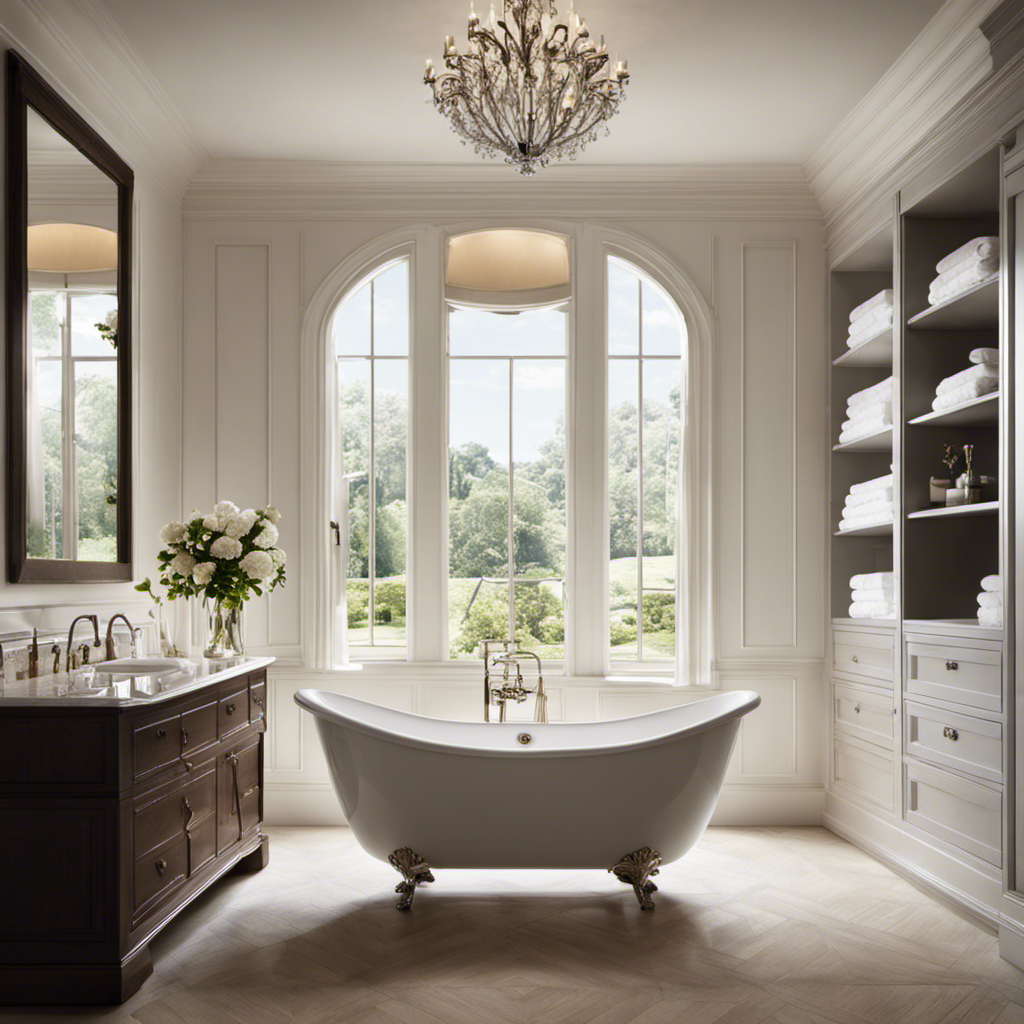As I step into the bathroom and ponder the dimensions of a normal bathtub, I am immediately struck by the importance of understanding its width. How wide is a normal bathtub? This question may seem simple, but the answer can vary greatly depending on the specific model and design.
In this article, we will delve into the world of standard bathtub widths, exploring average dimensions, typical sizes, and common bathing space widths. Get ready for a detailed and informative journey into the realm of bathtub measurements.
Key Takeaways
- Standard bathtubs typically range in width from 30 to 32 inches, making them ideal for small bathrooms with limited space.
- Average-sized tubs comfortably fit most people and are made from various materials such as acrylic, fiberglass, or porcelain-enameled steel.
- Larger tubs allow for more freedom of movement and a more luxurious bathing experience, accommodating couples or families.
- Optimal bathtub sizes for small bathrooms vary, but small bathtubs typically have a width of 30-32 inches, while walk-in tubs have a width of 26-32 inches.
Standard Bathtub Widths
Standard bathtubs typically range in width from 30 to 32 inches. These dimensions are ideal for small bathrooms where space is limited. A narrower bathtub allows for more room to move around and can make a small bathroom feel more spacious.
Additionally, these dimensions are also suitable for older homes, which often have smaller bathrooms due to the architectural styles of the time. The narrower width of standard bathtubs ensures that they can fit into older homes without the need for extensive renovations.
It is important to consider the dimensions of a bathtub when planning a bathroom remodel or renovation, as it can greatly impact the overall functionality and aesthetics of the space.
Average Bathtub Dimensions
You can typically find an average-sized tub that comfortably fits most people. These tubs, made from various materials such as acrylic, fiberglass, or porcelain-enameled steel, offer different benefits and considerations.
Acrylic tubs are lightweight and easy to clean, while fiberglass tubs are durable and affordable. Porcelain-enameled steel tubs are heavy-duty and resistant to stains and scratches.
When considering bathtub installation, it’s important to measure the available space in your bathroom to ensure a proper fit. Additionally, you should consider the weight of the tub and ensure that your bathroom floor can support it. Plumbing and water supply should also be taken into account, as well as any necessary modifications for a seamless installation.
Overall, choosing the right bathtub material and considering installation factors are essential for a successful bathroom renovation.
Typical Tub Sizes
For an average-sized tub that fits most people comfortably, it’s important to consider the typical sizes available.
When it comes to the ideal bathtub depth, a deeper tub can provide a more relaxing and luxurious bathing experience.
The benefits of larger tub sizes are numerous. Firstly, they allow for more freedom of movement, making it easier to stretch out and fully immerse yourself in the water. Additionally, larger tubs can accommodate couples or families, creating a shared bathing experience. They also provide ample space for bath accessories such as bath pillows or trays for holding books and drinks.
As we transition into the subsequent section about common bathtub widths, it’s important to note that the width of the tub is another crucial factor to consider in creating the perfect bathing experience.
Common Bathtub Widths
As we dive into bathtub widths, it’s worth noting that there is a wide range of sizes available to suit different bathroom spaces and personal preferences.
When it comes to bathtub materials, you have several options to choose from. Common materials include acrylic, fiberglass, cast iron, and porcelain. Each material has its own advantages and drawbacks in terms of durability, maintenance, and cost.
Moving on to depth and comfort, bathtub depth is an important consideration. Most standard bathtubs have a depth of around 14 to 17 inches. However, if you’re looking for a more luxurious bathing experience, you can opt for deeper soaking tubs that can have a depth of up to 22 inches. Deeper tubs provide better immersion and allow for a more relaxing soak.
Normal Bathing Space Widths
When it comes to the width of a standard bathtub, it’s important to consider the available space in your bathroom. Optimal bathtub sizes for small bathrooms can vary depending on the layout and dimensions of the room. Customizing bathtub widths for accessibility requirements is also crucial for individuals with specific mobility needs. To help you understand the different options available, I have created a table below showcasing various bathtub widths and their corresponding dimensions:
| Bathtub Size | Width (inches) | Width (centimeters) |
|---|---|---|
| Small | 30-32 | 76-81 |
| Standard | 32-36 | 81-91 |
| Wide | 36-42 | 91-107 |
| Clawfoot | 48-72 | 122-183 |
| Walk-in Tub | 26-32 | 66-81 |
Conclusion
So there you have it, the width of a normal bathtub. It’s a question that may seem simple, but the answer is anything but.
With standard bathtub widths ranging from 30 to 32 inches, and average dimensions falling around 60 inches long and 30 inches wide, there’s a lot to consider when it comes to choosing the right bathtub for your space.
But don’t worry, with these common bathtub widths and the knowledge of typical bathing space widths, you’ll be well-equipped to make an informed decision.










